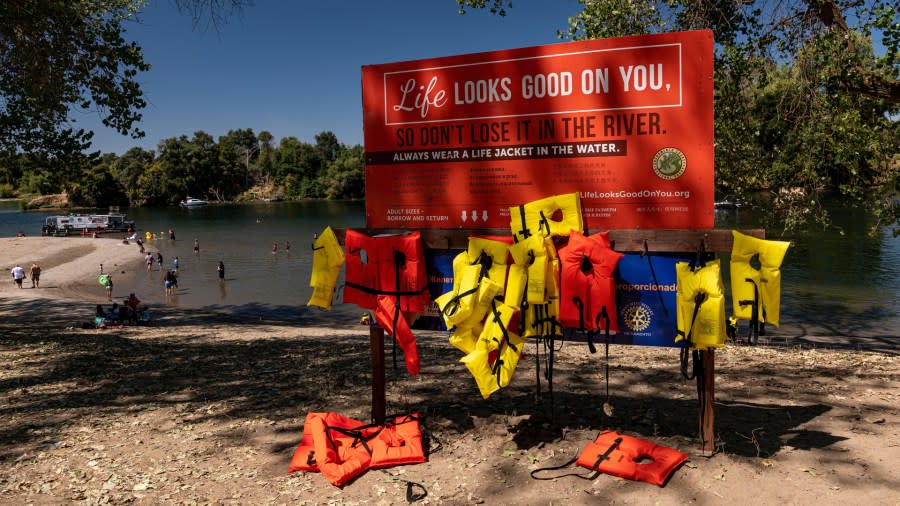Safety first: How to find the right life jacket for you

GRAND HAVEN, Mich. (WOOD) — Summer weather is here, which means Lake Michigan beaches will soon be swarming with swimmers. But before hitting the water, remember arguably the most important piece of safety equipment: a life jacket.
U.S. Coast Guard Petty Office 3rd Class James Ginnel has taken part in several rescue attempts in his time serving at the Grand Haven Coast Guard station and has seen how life jackets can make the difference between life and death. He said for water rescues, timing is everything and a life jacket can buy that.
“It gives us so much more time. When they might have to spend energy trying to swim and trying to (keep their heads above water), the life jacket will make sure they stay afloat until we can get to them,” Ginnel told News 8.
Lake Effect: What changes scientists are seeing on Lake Michigan
Getting ready to start his third summer at the Grand Haven station, Ginnel said he has helped rescue several people and, unfortunately, has also recovered the bodies of lost swimmers.
He recalled a rescue last summer near Muskegon State Park when a kite surfer was down in the water. Thankfully, she had a life jacket.
“We got there, she was maybe only a nautical mile off the (shore). The water was a little bit colder. She could have started going into hypothermia. … But if someone isn’t wearing a life jacket, you can see (the survival rate) go down drastically,” he said.
Lighted towers will show flag warnings at Grand Haven State Park
Aside from wearing life jackets, experts say it is also important to use one with the right fit.
According to Safe Kids Worldwide, parents should pay attention to the sizing listed on any life jacket. Jackets rated for infants are built to help carry anything between 8 and 30 pounds. A “child” life jacket is typically for kids between 30 and 50 pounds, and “youth” jackets are good up to 90 pounds.
Experts recommend testing the fit of a life jacket by putting it on and tightening all necessary straps or clasps, then lifting up on the shoulders of the jacket. If the jacket goes past a person’s chin or ears, it is either too big or the straps are too loose.

Life jackets, also referred to as portable floatation devices or PFDs, are broken down into categories based on how effective they are. According to the Michigan DNR, there are four recognized types of PFDs, ranging from the most effective Type I vests to Type IV, which are throwable devices like life preservers.
Lake Michigan Summer Beach Guide
Each life jacket has its own advantages and disadvantages.
Type I life jackets are considered the best for open water or rough surf. These are the typical orange vests that most boaters are familiar with, including a buoyant section behind the neck and across the chest. While they are bulky, they can be sized to fit most people and will position most people face-up in the water if they are unconscious.

Type II life jackets can look similar but may not have as much support around the neck and aren’t as bulky. What is being sacrificed for comfort can also have an impact on safety. According to the DNR, the slim jackets are less likely to position an unconscious person face-up in the water.
Type III jackets are for calm waters where a quick rescue is likely. These are more designed for water sports and activities, giving people more range of motion and less bulk. Unlike Type I and II life jackets, these will not flip an unconscious person face-up. Some Type III life jackets are even designed to lay flat and only inflate when you enter water, that way a person can wear it without dealing with the bulk of the life jacket.
Michigan state law mandates that all boats have proper PFDs for everyone on board and that all children under the age of 6 wear a Type I or Type II PFD when riding on a boat. Anyone towed by a boat should be in a life jacket, and all PFDs must be in serviceable condition and readily accessible.
Kids could earn reward for wearing their life jacket
Though life jackets are a big help, they are not a substitute for monitoring children. Safe Kids Worldwide recommends parents and caregivers keep young children and weak swimmers within arm’s reach and encourage older children to always swim with a partner.
Ginnel echoed the point, speaking from experience.
“Keep an eye on your kid. I know that’s kind of common knowledge, but just keep an eye on your kids,” he said. “Stay within the marked buoys. I know here at (Grand Haven) State Park, we have a swim zone. Stay within that swim zone. They are there for a reason. And go with other people in the water. Never go alone to the beach.”
Copyright 2024 Nexstar Media, Inc. All rights reserved. This material may not be published, broadcast, rewritten, or redistributed.
For the latest news, weather, sports, and streaming video, head to WOODTV.com.

